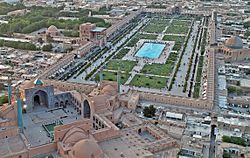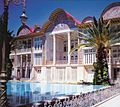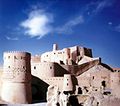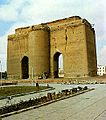Persian architecture facts for kids

Persian architecture (also called Iranian architecture) is the special way buildings have been designed and built in Iran for thousands of years. This amazing style includes everything from ancient temples to grand mosques and even beautiful Persian Gardens. It has a very long history, starting before the time of Islam and continuing to today.
Contents
What Makes Persian Architecture Special?
Persian architecture is known for its unique features. Builders often used special shapes like domes and arches. They also loved to decorate buildings with colorful tiles, intricate patterns, and beautiful calligraphy. Many buildings are designed to be cool in hot weather, using clever air circulation systems.
Ancient Wonders: From Ziggurats to Palaces
Iran has a rich history, and its ancient buildings show how clever people were long ago.
Ziggurats: Mountain-like Temples
One of the oldest types of buildings is the Ziggurat. Imagine a huge, stepped pyramid! A famous example is Chogha Zanbil, which is a UNESCO World Heritage Site. These ziggurats were like man-made mountains, built to honor gods and connect people to the heavens. They stood tall in flat areas, breaking up the landscape.
Grand Palaces of Ancient Empires
- Persepolis: About 2,500 years ago, during the Achaemenid Empire, a magnificent city called Persepolis was built. You can still see its impressive ruins today, including tall columns and grand halls. It was a ceremonial capital, used for important events.
- Palace of Ardashir: Built in 224 during the Sassanid Dynasty, this ancient palace shows early examples of large domes. It had three big domes, which were very advanced for their time.
- Pasargadae: This was the first capital of the Achaemenid Empire. It features large gardens and palaces, showing early Persian design ideas.
- Rayen Castle: Another Sassanid-era fortress, this large mud-brick castle shows the strength and design of ancient Persian defenses.
Beautiful Gardens and Clever Designs
Persian architecture isn't just about buildings; it's also about creating peaceful and beautiful spaces, especially gardens.
The Idea of Persian Gardens
Persian Gardens are famous worldwide. They are designed to be a paradise on Earth, often with water channels, fountains, and lots of trees and flowers. These gardens are usually divided into four parts, representing the four elements or four directions.
- Eram Garden: Located in Shiraz, this beautiful garden with its 18th-century building is a legacy from the Zand Dynasty.
- Khalvat-i Karim-khani: Found within the Golestan Palace gardens, this is another lovely example of a Persian garden, offering a quiet, peaceful space.
Smart Solutions for Hot Climates
Many traditional Persian houses and buildings have clever features to stay cool.
- Badgirs (Windcatchers): These special towers on rooftops catch cool breezes and direct them down into the building, acting like natural air conditioners.
- Courtyards and Basins: Houses like the 18th-century Abbasian House in Kashan often have central courtyards with pools of water. These help cool the air and create a calm atmosphere.
Islamic Era Masterpieces
After the arrival of Islam, Persian architecture continued to grow and develop, creating some of the world's most stunning mosques, tombs, and bridges.
Grand Mosques and Shrines
- Shah mosque: Located in Isfahan, this mosque is a perfect example of Persian domes and minarets (tall, slender towers). Its colorful tiles and grand scale are breathtaking.
- Jamkaran Mosque: This mosque is another beautiful example of Islamic Persian architecture, known for its unique design.
- Fatima Masumeh Shrine: In Qom, this shrine features intricate rooms and courtyards, showing detailed craftsmanship.
- Bibi-Khanym Mosque: Though located in modern-day Uzbekistan, this mosque shows strong Persian influences in its design and decoration.
Impressive Towers and Tombs
- Kharāghān twin towers: Built in the 11th century, these towers are remarkable examples of early Islamic brickwork and geometric patterns.
- Tomb of Ahmad Sanjar: In Merv, this medieval structure with its typical Persian dome is a great example of Seljuq-period architecture.
- Gur Emir: This mausoleum, also showing strong Persian influences, is famous for its ribbed turquoise dome.
Iconic Bridges
- Si-o-se Pol: One of the famous bridges in Isfahan, this bridge is not just for crossing a river but also a beautiful work of art with many arches.
Modern Persian Architecture
Persian architecture continues to evolve, blending traditional ideas with modern styles.
- Azadi Tower: This famous landmark in Tehran was designed by Hossein Amanat. It combines classical Persian shapes with modern ideas, creating a unique symbol for the city.
- Tehran Museum of Contemporary Art: Designed by Kamran Diba, this museum uses traditional Iranian elements like Badgirs but has a spiraling inside, similar to modern Western designs.
- Iran Senate House: Designed by Heydar Ghiai, this building mixes traditional Persian stories and symbols with modern architecture.
- Tehran University College of Social Sciences: This building clearly shows design elements inspired by ancient Persepolis, connecting modern education with a rich past.
- Isfahan International Conference Center Mosque: This mosque shows how modern architecture can still use the classic dome shape in new and exciting ways.
Images for kids
-
The ruins of Persepolis, built 2500 years ago during the reign of the Achaemenid Empire.
-
Si-o-se Pol, one of the bridges of Isfahan.
-
The Eram Garden in Shiraz is an 18th-century building and a legacy of the Zand Dynasty.
-
A hujra (room) at Atabaki sahn at Fatima Masumeh Shrine, Qom.
-
The ancient Palace of Ardashir, constructed in 224 during the Sassanid Dynasty. The building has three large domes, among the oldest examples of such large-scale domes in the world.
-
The tomb of Seljuq sultan Ahmad Sanjar in Merv, Turkmenistan. The medieval structure with a typical Persian dome is a fine example of the Seljuq-period Persian architecture.
-
Ziggurats such as the UNESCO designated World Heritage Site of Chogha Zanbil, which relieved the flat monotony of the southern Khuzestan plane, were but "ritual imitations of the familiar sacred mountains which ring the Iranian plateau".
-
Hatra in Nineveh, Iraq. From the 3rd to 1st century BCE, although no archeological information on the city before the Parthian period but settlement in the area likely dates back to at least the Seleucid period. Hatra was a religious and trading center. Today it is a World Heritage Site, protected by UNESCO.
-
The mosque of Isfahan international conference center – modern architecture of dome.
-
Houses: The 18th century Abbasian House, Kashan.
-
Jamkaran Mosque.
-
Tehran's Museum of Contemporary Arts designed by Kamran Diba is based on traditional Iranian elements such as Badgirs, and yet has a spiraling interior reminiscent of Frank Lloyd Wright's Guggenheim.
-
Tehran University College of Social Sciences shows obvious traces of architecture from Persepolis.































